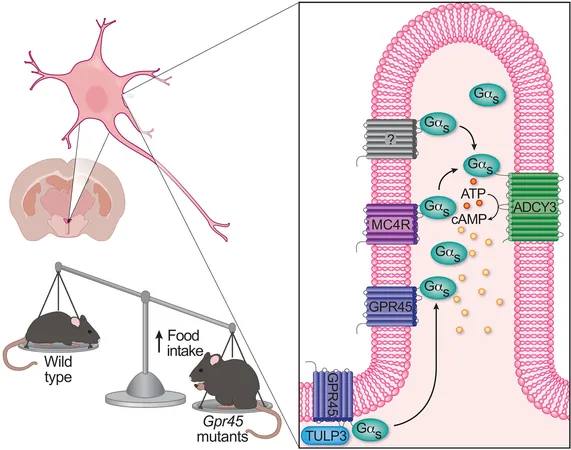
Unlocking the Secrets of Overeating: The Gpr45 Gene and Its Role in Appetite Control
2025-06-06
Author: Jia
Revolutionary Discovery in Obesity Research
Researchers at UT Southwestern Medical Center have made a groundbreaking discovery that could transform our understanding of overeating and obesity. Using an innovative technique called Automated Meiotic Mapping (AMM), they’ve identified a critical gene, Gpr45, that appears to regulate food intake.
What This Means for the Fight Against Obesity
Published in the prestigious journal Science, these findings could pave the way for new anti-obesity treatments, targeting a condition that plagues nearly 40% of adults in the U.S. and over a billion people globally. "This research reveals a previously unknown signaling pathway involving tiny, antenna-like structures on brain neurons, integral in the appetite control process," stated study leader Zhao Zhang, Ph.D.
New Frontiers in Weight Management Solutions
The onslaught of weight-loss drugs in recent years has already revolutionized healthcare, offering lasting results and improving cardiovascular health, blood sugar levels, and cholesterol management. The discovery of Gpr45 opens avenues for new treatment options that could work alongside current medications to help manage appetite and tackle obesity effectively.
Understanding Genetics Behind Weight Gain
Body weight regulation is a complex interplay of genetic and environmental factors. Identifying genetic mutations related to human weight gain is notoriously difficult due to the diverse diets and lifestyles. To unravel these genetic clues, Dr. Zhang and his team employed forward genetics enhanced by the AMM technique.
How AMM is Changing the Game
Co-authored by Nobel Laureate Bruce Beutler, the AMM process involves inducing genetic mutations in mice, screening for specific traits, and pinpointing the mutations through advanced genotypic analysis combined with artificial intelligence. This method led researchers to focus on the Gpr45 gene, where two distinct mutations were associated with obesity even on a regular diet.
The Crucial Role of Gpr45
Using CRISPR gene-editing technology, deleting the Gpr45 gene in healthy mouse embryos confirmed its crucial role in weight regulation. The results showed that dysregulated feeding behaviors began at six weeks of age, with these mice overeating compared to their normal counterparts.
Gpr45: A Key Player in Hypothalamic Appetite Control
Investigations revealed that GPR45 protein is active in the hypothalamus, particularly in the primary cilia—tiny cellular extensions crucial for cellular signaling. This discovery aligns with previous studies linking other appetite-regulating proteins, like MC4R, to obesity, especially in rare genetic disorders known as ciliopathies.
Navigating the Cilia and Appetite Connection
Dr. Zhang's team found that GPR45 acts as a transporter that moves Gαs protein into primary cilia, which in turn activates MC4R to control appetite. Mutations in Gpr45 disrupt this transport, keeping MC4R inactive and leading to overeating in the affected animals.
Future Potentials in Obesity Treatments
Currently, two MC4R-targeting drugs are available, yet they are limited to treating obesity linked to rare genetic mutations. Dr. Zhang suggests that enhancing GPR45's activity could lead to groundbreaking treatments, potentially offering new hope in the battle against obesity for a broader range of individuals.





 Brasil (PT)
Brasil (PT)
 Canada (EN)
Canada (EN)
 Chile (ES)
Chile (ES)
 Česko (CS)
Česko (CS)
 대한민국 (KO)
대한민국 (KO)
 España (ES)
España (ES)
 France (FR)
France (FR)
 Hong Kong (EN)
Hong Kong (EN)
 Italia (IT)
Italia (IT)
 日本 (JA)
日本 (JA)
 Magyarország (HU)
Magyarország (HU)
 Norge (NO)
Norge (NO)
 Polska (PL)
Polska (PL)
 Schweiz (DE)
Schweiz (DE)
 Singapore (EN)
Singapore (EN)
 Sverige (SV)
Sverige (SV)
 Suomi (FI)
Suomi (FI)
 Türkiye (TR)
Türkiye (TR)
 الإمارات العربية المتحدة (AR)
الإمارات العربية المتحدة (AR)